|
|
|
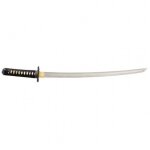 |
|
| Hanwei Fuku Riu Wakizashi (CH1666) |
Points: 50

|
Through Japanese history, dragons have been an integral part of the life and lore of Japan. This series has been designed to commemorate some of the most well know dragons found in Japanese myth and legend. Paul Chen’s Forge and designers have brought to life in this sword series not only a unique idea, but unique swords never before attempted in this genre.
Fuku – Riu - Japanese Dragon of Good Luck
Little is known of the Fuku-Riu. It is said, however, that if seen good fortune and luck will soon follow the beholder. The dragon is often depicted ascending heaven-ward, a sign of success in some circles. We have depicted this ascension in the Tsuba of the Fuku-Riu. The pearl being held by the dragon is also a sign of good luck and wealth. The design of this tsuba is a first for master sword maker Paul Chen and unique to this collection. The saya design is also unique to the series as it is a black-green blend…green being a color associated in Japanese history with luck. The Fuku-Riu dragon is rare in the literature of Japanese history but still a very important and integral part of the Tatsu Collection and a fitting first for this series.
Sold Out
|
|
|
|
|
|
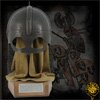 |
|
| Hanwei Gjermundbu Helmet (AH2190N) |
Points: 20
|
The Gjermundbu Helm is based on a classic Viking helm found in a Norwegian burial mound. Found in nine fragments, the helm has been re-constructed and is now housed in the Museum of National Antiquities in Oslo. It dates from around 970 A.D. and is considered to be the finest helm found from that era. The "spectacles" (officially "occularia"), provided excellent facial and nasal protection, while chain mail provided flexible protection to the back and sides of the neck. As with the original, our Gjermundbu helm is provided with a leather chin strap.
Sold Out
|
|
|
|
|
|
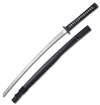 |
|
| Hanwei Gorin Iaito |
Points: 30

|
Iaito have long been the preferred training tools for safe practice of the many Japanese sword drawing arts typically known as Iaido. While not designed for sword-on-sword contact or actual test cutting, the un-edged iaito is perfectly weighted and balanced for its designed task of safe, repetitive drawing practice.
The Nami, Gorin, and Tsuru iaito are a breakthrough in design and functionality. Made of a special stainless steel, the blades are much more durable than iaito blades made from aluminum alloy, with a "live" feel and much superior rigidity. Through a special tempering process, these Iaito blades eliminate the brittle behaviour sometimes associated with stainless steel, while retaining its low maintenance and rust-resistant qualities. These very affordable Iaito are the ideal training tools for safely praciticing this ancient art.
White Same w/ Matte Leather Ito, Black Cotton Sageo
Musashi Tsuba, Brushed Fuchi & Kashira
Silver Menuki, Habaki, Seppa, Shitodome
Sold Out
|
|
|
|
|
|
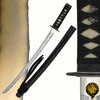 |
|
| Hanwei Gorin Iaito Wakizashi (SH5020) |
Points: 20


|
Iaito have long been the preferred training tools for safe practice of the many Japanese sword drawing arts typically known as Iaido. While not designed for sword-on-sword contact or actual test cutting, the un-edged iaito is perfectly weighted and balanced for its designed task of safe, repetitive drawing practice.
The Nami, Gorin, and Tsuru iaito are a breakthrough in design and functionality. Made of a special stainless steel, the blades are much more durable than iaito blades made from aluminum alloy, with a "live" feel and much superior rigidity. Through a special tempering process, these Iaito blades eliminate the brittle behaviour sometimes associated with stainless steel, while retaining its low maintenance and rust-resistant qualities. These very affordable Iaito are the ideal training tools for safely praciticing this ancient art.
White Same w/ Matte Leather Ito, Black Cotton Sageo
Musashi Tsuba, Brushed Fuchi & Kashira
Silver Menuki, Habaki, Seppa, Shitodome
Sold Out
|
|
|
|
|
|
 |
|
| Hanwei Great Wave - Tsunami Wakizashi (SH5002) |
Points: 30

|
Each piece in the Great wave Series (SH5004, SH5002, & SH5022) is stylized with the renowned Tomoe motif. The tsuba, fuchi, & kashira are made of black iron and marked with the Tomoe crest (mon). The blades are hand-forged from T10 high-carbon steel and are differentially tempered using traditional claying methods. The temper line (hamon) is evident and prominent. Each piece has a deeply lacquered black saya with a one-piece brass habaki construction. Real ray skin (same) is used on the tsuka, and the tsuka-ito and sageo are made of premium woven Japanese black cotton. The katana and wakizashi are constructed with a large o-kissaki and are ideal for cutting exercises (tameshigiri). The handle on the tanto is an attractive ribbed buffalo horn.
High-carbon steel
Deeply lacquered black saya
Ideal for cutting exercises
Sold Out
|
|
|
|
|
|
 |
|
| Hanwei Gustav Rapier Antiqued (SH2206N) |
Points: 12
|
The Gustav Rapier and Main Gauche replicate weapons used by King Gustav Adolf II, who ruled Sweden in the early part of the 17th century. The shell guard of the rapier is unusual but effective. Available in both bright and antiqued versions. A replacement live blade is also available (OH2327).
All of our rapiers have stainless steel hilts, for reduced maintenance, and high-carbon steel flex-tempered blades. Our three swept-hilt styles (Solingen, Torino, Gustav) are available with hilts in both polished and antiqued finishes. The latter finish, developed by Hanwei, has allowed a museum-quality patina to be applied to stainless steel while the non-corroding properties of the steel are retained. This finish is extremely attractive and gives a very authentic appearance to the piece.
Sold Out
|
|
|
|
|
|
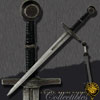 |
|
| Hanwei Hand and a Half Letter Opener (MH2249) |
Points: 2


|
The Hand-and-a-Half Sword, so-called because it could be used a either a single-handed or two-handed weapon, provided powerful versatility for the knights of the 14th and 15th centuries. Classically simple in design, the sword is featured in many European illustrations and stone carvings of the period.
Sold Out
|
|
|
|
|
|
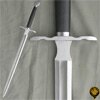 |
|
| Hanwei Hand and a Half Sword (SH2365) |
Points: 11

|
Hand-and-a-Half Sword, this version of a 16th century piece are a longtime favorite. Balance is excellent, providing a sword which lends itself to both single and two-handed use. Iberia Swords are crafted in much the same way as swords were made centuries ago, except that the blades are now forged from high-carbon spring steel, a resource unavailable off-the-shelf to the smiths of the old. The blade finish is far from being polished, again more closely replicating what the medieval swordsmith was able to achieve. Except as noted, grips are leather-covered hardwood. Fittings are either steel or solid brass. Except, where shown all of these swords have scabbards of leather-covered fiberglass with steel lockets and chapes and removable suspension rings. These swords will appeal to the re-enactor who wants a sword with the same appearance as the originals.
Sold Out
|
|
|
|
|
|
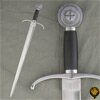 |
|
| Hanwei Henry V Sword (SH2369) |
Points: 11

|
The Henry V Sword is modeled after the sword hung over the tomb of one of England's great warrior kings. The single-handed cut-and-thrust weapon combines a relatively short sturdy blade with elegant down-swept quillons and a wheel pommel. Iberia Swords are crafted in much the same way as swords were made centuries ago, except that the blades are now forged from high-carbon spring steel, a resource unavailable off-the-shelf to the smiths of the old. The blade finish is far from being polished, again more closely replicating what the medieval swordsmith was able to achieve. Except as noted, grips are leather-covered hardwood. Fittings are either steel or solid brass. Except, where shown all of these swords have scabbards of leather-covered fiberglass with steel lockets and chapes and removable suspension rings. These swords will appeal to the re-enactor who wants a sword with the same appearance as the originals.
Sold Out
|
|
|
|
|
|
 |
|
| Hanwei Iga Ninja-To (SH2431) |
Points: 15

|
The neighboring Kouga and Iga clans of feudal Japan were bitter enemies for centuries and their warring Ninja families have been immortalized in Japanese literature. To commemo- rate these secretive warriors we have introduced our Kouga and Iga Ninja-To.
Sold Out
|
|
|
|
|
|
 |
|
| Hanwei Japanese Arrowhead Stand (OH2235) |
Points: 3
|
Our Arrowhead Display Stand is beautifully crafted in black lacquered wood in a traditional form and will showcase up to 6 arrowheads for the collector or decorator.
Sold Out
|
|
|
|
|
|
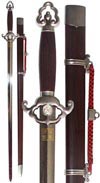 |
|
| Hanwei Jian Tai Chi Sword |
Points: 8
|
Jian Tai Chi Sword
Designed by world-renowned Chinese martial arts master Sifu Adam Hsu, these Chinese straight swords (Jian) are sure to become the standard in the martial arts community. With function and performance in mind during the design, these jian are constructed for martial artists. The blades are made of high-carbon spring steel with a ridgeline going down the center producing an intense audible feedback when swung. The Ming-style guard is a beautifully ornate with an embossed Dragon symbol. The pommel is open-ended to allow for a tassel. The handle and scabbard are made of a high-resistance wood-grain polymer for durability and strength. Also, the handle has grooves running down it to increase sensitivity when held. One unique feature is the duck-bill lock in the bottom of the scabbard that securely holds the sword in place. Sifu Adam Hsu has done the martial arts community a great service in designing such an affordable and functional sword. This sword is available in three distinct blade sizes SH2269A – 28, SH2269B – 30, SH2269C – 32.
High-carbon spring steel
Ming-style guard
High-resistance wood-grain polymer scabbard
Sold Out
|
|
|
|
|
|
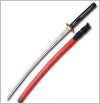 |
|
| Hanwei Kami Katana (SH1201) |
Points: 60
|
Each piece in the Kami group has a hand-forged and folded ASSAB-K120C powder steel blade, differentially tempered to produce an HRC60 edge, HRC40 back and a distinctive hamon. Saya are deeply lacquered in red, with a black ring-carved section at the sageo. The ray skin used on the tsuka is of the highest quality, and the tsuka-ito on the Katana and Wakizashi and the sageo on all three pieces are woven from best quality Japanese silk. The Fuchi, Kashira, Kojiri, Koiguchi and Kurigata are all made from blackened bronze, with decoration in relief and selective detailing of copper, silver and gold. The Tsuba of the Katana and Wakizashi, depicting the Kami, or Guardian Warriors, are made from hardened blackened copper, with decoration in relief and selective silver and gold detailing. The Habaki is of two-piece construction, the inner section being copper and the outer section gold-plated brass. The blades are engraved, at the Habaki, with a hand-engraved "Fudo" horomono, a traditional blade carving from the Edo period. The blades of all three pieces are grooved on both sides, and each piece features a long Kissaki. See Models SH1202 and SH1203 for the Wakizashi and Tanto details.
Forged-Folded K120C High-Carbon Steel
Differential Heat-Treatment
Traditional Construction
Sold Out
|
|
|
|
|
|
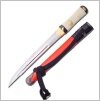 |
|
| Hanwei Kami Tanto (SH1203) |
Points: 30
|
Each piece in the Kami group has a hand-forged and folded ASSAB-K120C powder steel blade, differentially tempered to produce an HRC60 edge, HRC40 back and a distinctive hamon. Saya are deeply lacquered in red, with a black ring-carved section at the sageo. The ray skin used on the tsuka is of the highest quality, and the tsuka-ito on the Katana and Wakizashi and the sageo on all three pieces are woven from best quality Japanese silk. The Fuchi, Kashira, Kojiri, Koiguchi and Kurigata are all made from blackened bronze, with decoration in relief and selective detailing of copper, silver and gold. The Tsuba of the Katana and Wakizashi, depicting the Kami, or Guardian Warriors, are made from hardened blackened copper, with decoration in relief and selective silver and gold detailing. The Habaki is of two-piece construction, the inner section being copper and the outer section gold-plated brass. The blades are engraved, at the Habaki, with a hand-engraved "Fudo" horomono, a traditional blade carving from the Edo period. The blades of all three pieces are grooved on both sides, and each piece features a long Kissaki. See Models SH1201 and SH1202 for the Katana and Wakizashi details.
Hand forged and folded steel blades
Top-of-the-Line quality
Traditional construction
Sold Out
|
|
|
|
|
|
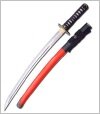 |
|
| Hanwei Kami Wakizashi (SH1202) |
Points: 50
|
Each piece in the Kami group has a hand-forged and folded ASSAB-K120C powder steel blade, differentially tempered to produce an HRC60 edge, HRC40 back and a distinctive hamon. Saya are deeply lacquered in red, with a black ring-carved section at the sageo. The ray skin used on the tsuka is of the highest quality, and the tsuka-ito on the Katana and Wakizashi and the sageo on all three pieces are woven from best quality Japanese silk. The Fuchi, Kashira, Kojiri, Koiguchi and Kurigata are all made from blackened bronze, with decoration in relief and selective detailing of copper, silver and gold. The Tsuba of the Katana and Wakizashi, depicting the Kami, or Guardian Warriors, are made from hardened blackened copper, with decoration in relief and selective silver and gold detailing. The Habaki is of two-piece construction, the inner section being copper and the outer section gold-plated brass. The blades are engraved, at the Habaki, with a hand-engraved "Fudo" horomono, a traditional blade carving from the Edo period. The blades of all three pieces are grooved on both sides, and each piece features a long Kissaki. See Models SH1201 and SH1203 for the Katana and Tanto details.
Hand forged and folded steel blades
Top-of-the-Line quality
Traditional construction
Sold Out
|
|
|
|
|
|
|
|
Tags:
swords, sword, katana, wakizashi, tanto, japanese sword, medieval sword, viking sword, japanese swords, medieval swords, viking swords, knife, knives, saber, armour, movie swords, movie replicas, martial arts, sporting goods, sporting equipment,
|
















